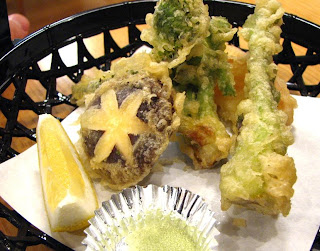It's a surprise that tempura was not originally a Japanese dish. It actually originates to visiting Portuguese in the 16th century. But tempura, slowly adapted itself to Japanese taste. By the late nineteenth century tempura was a popular fast food in Tokyo, sold everywhere. And today's modern tempura (made by deep-frying vegetables, fish and shellfish) is no longer regarded as a foreign food at all, but a completely part of the Japanese and Tokyo culture.
In Tokyo, Tempura restaurants are called tenpuraya(天ぷら屋, literally tempura house), ranging from fast food chains to very 5-star restaurants. Many restaurants offer tempura as part of a bentō (弁当, lunch box), and it is also a popular ingredient in take-away or convenience store bentō.





